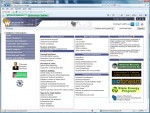Before I get to the Social Security Administration’s Office of the Chief Actuary’s score of Paul Ryan’s Roadmap for America’s Future, I do have to recap the March 2010 “Trust Fund” performance. The combined funds took in $51,549 million in total income, including $97 million in “interest”, and paid out $58,296 million. That resulted in a gross monthly deficit of $6,747 million (3rd-worst peformance since monthly records from 1987 became available, beaten only by February 2010 and an anomalous August 1990) and a primary (cash) deficit of $6,844 million (4th-worst performance since 1987, behind the two aforementioned months and December 2009). The 12-month changes in the trust funds were +$102,423 million gross (worst since 12/1997-11/1998) and -$15,833 million primary (worst since monthly records were kept in 1987).
Once again, both components of the fund ran both gross and primary monthly deficits – the Disability Insurance fund ran a $2,881 million gross/$2,902 million primary monthly deficit (12-month deficits of $15,688 million gross, bringing its balance to under $200,000 million, and $26,159 million primary), and the Old-Age and Survivors Insurance fund ran a $3,864 million gross/$3,940 million primary monthly deficit (12-month surpluses of $118,115 million gross and $10,257 million primary, the latter its worst performance since the effects of an anomalous performance in November 1994 were aged off).
That brings me to the OACT’s scoring of the Roadmap. They dusted off their 2009 Intermediate Scenario, plugged Ryan’s proposal into it, and pronounced that it would make Social Security solvent over a 75-year period with no net transfers from the general fund (I can’t stress the “net” enough). How does that happen? Let’s take a look at Ryan’s plan:
- The big one is the partial-privatization. Starting in 2012, those who hadn’t turned 55 yet could divert a part of their Social Security tax to a personal retirement account managed much like the government employees’ Thrift Savings Plan. That starts at 2% of the first $10,000 of covered earnings and 1% of covered earnings in excess of $10,000 (that indexed for inflation), rising to the maximum 8%/4% in 2042.
Those who participate would have their “traditional” Old-Age and Survivor Insurance (the main part of Social Security) payments reduced by the percentage of theoretical maximum participation (i.e. those who fully-participate starting in 2042 would receive $0 in “traditional” OASI payments). However, they would receive a guarantee that their account balance at retirement would not be less than their contributions accumulated by the rate of inflation (Consumer Price Index for Urban Wage Earners and Clerical Workers), with Social Security making up any shortfall.
At retirement, they would be required to purchase annuities that, combined with any OASDI (this includes any disability payments from Social Security) payments, would guarantee them monthly payments of at least 150% of the federal poverty level. The entirety of the personal retirement account, including the annuities, any excess amount after purchase of the annuities, and any pre-retirement death distributions to a designated beneficiary or the estate, would be tax-free.
- Potentially the most-controversial part is capturing employer-provided health-care benefits in the payroll tax. I’ll let the OACT summary describe it – “Specifically, any cost toward such group health insurance borne by employees would cease to be deductible, and the cost borne by employers would now be allocated to employees as if it had been wages, for the purpose of payroll tax (and later, benefit) calculations. Both employee and employer OASDI payroll taxes would be affected by this proposal.”
- The first of two elements to make Social Security more “progressive” also may face problems: the top-earning 70% of newly-retiring workers starting in 2018 would have their OASI benefit-growth rates reduced from average wage growth to, those making at least the maximum taxable amount having benefit-growth rate at average CPI growth. Those between the maximum taxable amount and the 30th-percentile would have a sliding-scale reduction of growth to somewhere between CPI and wage growth, and the bottom 30% would see no change.
- The second “progressive” element would increase OASI benefits for those making less than 200% of the 2009 minimum wage (indexed for wage growth) for more than 20 years, reaching a maximum OASI payment level of 120% of the poverty level (assuming no PSA participation) for those making the 2009 minimum wage (indexed) for at least 30 years.
- The Normal Retirement Age change would be accelerated from 67 in 2022 to 67 in 2021, and indexed to keep it at 20 years below the life expectancy thereafter.
- The solvency of the “Trust Funds” would be statutorially-guaranteed at 100% of the following year’s estimated cost (the Trust Fund Ratio), with the Treasury selling bonds to cover the cost. The “Trust Funds” would be authorized to repay that up to the point of the Trust Fund Ratio being a minimum of 125%.
I’ve been a bit too busy to fully take a look at it to see what could be culled and still have it make long-term actuarial sense. The taxation of employer health benefits isn’t “exactly” supportable, and the “Trust Funds” will continue to be raidable. Given the two scenarios that the OACT provided, I don’t know if the solvency guarantee is necessary.

